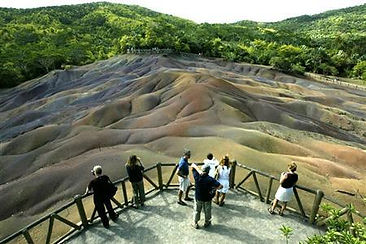
The Red Ruffed Lemur
Organizations and Reserves
The Duke University Lemur Center’s Masoala National Park:
The future of wild populations of the Red Ruffed Lemur became much brighter when, in March of 1997, the 840 square mile Masoala National Park, Madagascar’s largest protected area, was established. Previous to the establishment of this park, deforestation in their range and hunting and trapping of the ruffed lemurs for food had dramatically reduced their numbers. Principal threats to red-ruffed lemur survival are currently habitat loss and hunting (Duke, 2015).
Due to the ruffed lemurs large size and apparent need for intact primary forest, it is particularly susceptible to human encroachment and possibly selective cutting of the most precious hardwoods (ie rosewood) which, unfortunately has been occurring all over Madagascar since the start of the most recent political crisis (Duke, 2015) .
The most recent IUCN assessment places Red Ruffed Lemur, with its very limited range, in the critically endangered category (despite its presence in a major national park) because of the increase in illegal logging and hunting of Varecia in conjunction with logging camps inside Masaola National Park. The captive population is managed by a Species Survival Plan. The DLC maintains 20 red ruffed lemurs (10 males and 10 females), which includes two breeding groups (Duke, 2015).
The Duke University Lemur Center’s SAVA Region:
Starting in 2012, the Duke Lemur Center (DLC) began an independent conservation initiative, in the SAVA (Sambava-Andapa-Vohemar-Antalaha) region of northeastern Madagascar. This region contains over 820 square kilometers of mountainous primary rainforest in protected areas which include Marojejy National Park, part of the Rainforests of the Atsinanana World Heritage Site (Duke, 2015).
The mission of SAVA Conservation is to encourage biodiversity conservation in the SAVA region by supporting the livelihoods of rural people in forest bordering communities and through collaborations with local environmental organizations and governmental institutions to promote environmental education, reforestation, freshwater fish farms, family planning, fuel-efficient cook stoves, and conservation oriented lemur research projects (Duke, 2015).
The Anjanaharibe-Sud Special Reserve:
Lemur Conservation Foundation is supporting projects in Anjanaharibe-Sud Special Reserve (ASSR), a large mountainous rainforest in northeastern Madagascar, which has long been recognized as a lemur priority site that has received little attention. LCF has partnered with the Madagascar National Parks to provide boundary demarcations for this protected area and is working towards developing a site called Camp Indri into a functioning base camp for tourists and researchers (Lemur, 2009).
The Lemur Conservation Foundation
The Lemur Conservation Foundation operates a 100 acre reserve in Myakka City, Florida. The reserve is set up with two semi free-ranging forests, each approximately ten acres, and two traditional enclosure buildings.
As a Certified Related Facility with the Association of Zoos and Aquariums, The LCF participates in the Eulemur Species Survival Plan (SSP), Ruffed Lemur SSP, and Ring-tailed Lemur SSP, which include a global network of institutions working towards the propagation of selected lemur species in order to ensure the healthy existence of those species whose survival is in peril (Lemur, 2009).
The Myakka City Lemur Reserve:
The 100 acre Myakka City Lemur Reserve is located in extreme eastern Manatee County surrounded on all sides by agriculture. A variety of habitat types occur on the site due to topographical gradients, various soil types and historical land-uses, allowing environmental diversity on the reserve.
The vegetation zones are defined as oak-pine mixed forest, upland coniferous forest, live oak hammock, mixed rangeland, pine flatwoods, scrub and brush land, palmetto prairie, freshwater marsh, and wetland mixed forest. The lemur enclosures are located in the forests. Every effort is being made to maintain the colony in as natural a state as possible so that behavioral research will be maximally unbiased (Lemur, 2009).
The Foundation works closely with Duke University Lemur Center, Dr. Ian Tattersall and the rest of the LCF Scientific Advisory Council, the Association of Zoos and Aquariums (AZA) Prosimian Taxon Advisory Group, and the Species Survival Plan (SSP) coordinators to ensure that the colony is maintained and utilized as a prime research and breeding resource (Lemur, 2009).
This species is listed on Appendix I of CITES (IUCN, 2015). It is protected officially only within the Masoala National Park and the Makira Protected Area. However, Masoala was the national park most heavily impacted on by the very rapid upsurge of illegal logging after the political events of early 2009.
Increased regulation and management of illegal logging and hunting within the range is recommended. As of 2009, there were 590 red ruffed lemurs reported in captivity worldwide. Such populations in American and European zoos represent a safeguard against extinction, but they are unfortunately very limited in their genetic diversity (Duke, 2015).
The LCF also hosts field training programs, in which professors and their students utilize the facility and the lemur colony for behavioral observations and research on social dynamics and cognitive skills, as well as habitat use and food selection.
These training programs produce future primatologists and conservation biologists which will carry the conservation imperative forward for lemurs and other endangered species and fostering and inspiring conservation based careers is an invaluable part of The LCF’s mission (Lemur, 2009).

There are a few diffrent organizations and reserves that have been esatablished in an attempt to revitalize the dwindling population of the Red Ruffed Lemur. Keep in mind that this list does exclude zoos and private orgainzations as there are too many to mention. The reserves, parks, and organizations listed here have played a key role in lemur rehabilitation and education and you are encouraged to look into more deatil as each operation is uniqe and eduactional as well.
Overview:
Click on this photo to read more about illegal logging and regulation of parks in a beautiful presentation by Sara Marie Mc Carthy, Aaron Schlenker, Milind Tambe, and Christopher Kiekintveld







